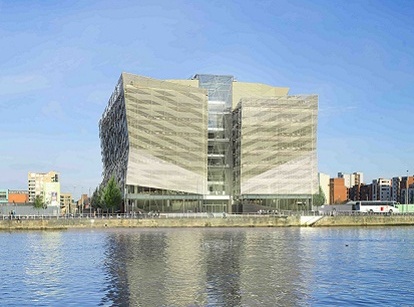 The Central Bank of Ireland’s new riverside headquarters in Dublin has placed a central focus on sustainability which has seen it gain a BREEAM Design Stage Outstanding rating, making it the first office building in Ireland to do so.
The Central Bank of Ireland’s new riverside headquarters in Dublin has placed a central focus on sustainability which has seen it gain a BREEAM Design Stage Outstanding rating, making it the first office building in Ireland to do so.
The Central Bank of Ireland (CBOI)’s relocation from its previous three city centre sites in Dublin to a new docklands site on the banks of the River Liffey provides a consolidation of its operations which promises far greater efficiency. It will also enable the Bank to meet its key sustainability goals in a purpose-built, energy efficient building with low operating costs and a healthy indoor environment for staff.
The achievement has been verified by the 19,300 m2 building, which is currently under construction, gaining BREEAM Outstanding certification at Design Stage with an impressive 86.7% out of the available credits. The project team, which includes architects Henry J Lyons, contractor Walls Construction and M&E engineer O’Connor Sutton Cronin, have taken a fully collaborative approach to exceeding the sustainability objectives, which was rewarded in the project’s top score of 100% for Management.
The client required a sustainability assessment framework that would guide it through a holistic method of achieving a sustainable, high performing, energy efficient building. After undertaking research, BREEAM was identified as the idea tool to measure and independently verify the building’s credentials across a wide range of areas and which included a strong focus on end user requirements.
The scheme received exemplary scores of 91.3% for Energy and 88.89% for Pollution as a result of meeting the project’s goals on operational energy efficiency in operation including the specification of a CHP plant and an advanced ventilation system. Transport was also strongly rated at 88.89% – and key to this is the city centre location, excellent public transport networks and the provision of cyclist facilities.
Design solution
Several key elements within the building’s design have helped it become a pioneering sustainability project in Ireland’s commercial sector saving 70% on energy compared with Irish Building Regulations. These include a mixed mode ventilation system to provide good quality air and reduce energy consumed. Within predetermined temperature parameters, façade-mounted louvres will open allowing fresh air to enter the space, and the Building Management System will simultaneously reduce fresh air supply from HVAC units, saving energy.
In addition to the CHP plant which will reduce the building’s CO2 emissions and energy costs in operation, extensive sub-metering for lighting, small power and energy for heating will link to the BMS and enable the end user to establish detailed information on energy consumption.
Extensive cycle facilities have been specified over and above BREEAM requirements totalling 300 cycle racks against the 53 required as well as 30 showers to encourage staff to use sustainable transport.
The BREEAM process helped the project team achieve key objectives on energy efficiency, resource consumption reduction and lower energy costs in operation, with the criteria under the assessment method’s Energy category enabling CBOI to focus on the main items to aid in achieving their aspirations.
Waste minimisation is a major objective of CBOI for the project, and following the BREEAM criteria within the Waste category was also beneficial in enabling CBOI to define goals in not only design, but also during construction and in post occupancy. As well as reducing waste to landfill, the project is committed to only using FSC certified timber as well as responsibly sourced materials with low VOCs.
Deirdre Quigley, Senior Programme Manager at Central Bank of Ireland commented on how BREEAM has helped to facilitate the design process so far: “BREEAM provided us with a methodology to independently measure our corporate goals to achieve a fully sustainable building and to improve the health and well-being of our staff. In addition it has enabled us to project a sustainable international image by providing respected third party verification of the building.”

